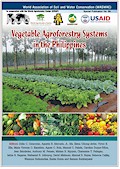| Book Chapter |
 |
|
| Title | Vegetable-Agroforestry (VAF) System: Understanding Vegetable- Tree Interaction as a Key to Successful Vegetable Farming in the Uplands of Southeast Asia | | Author | Agustin Mercado, Jr., Caroline Duque-Piñon, Manuel C. Palada and Manuel Reyes | | Editors | Delia Catacutan, Agustin Mercado, Jr., Ma. Elena Chiong-Javier, Victor B. Ella, Victoria O.Espaldon, Agnes C. Rola, Manuel C. Palada, Caroline Duque-Piñon, Jean A. Saludadez, Anthony M. Penaso, Miriam R. Nguyen, Charmaine Pailagao, Isidra B. Bagares, Nathaniel R. Alibuyog, David Midmore, Manuel Reyes, Rebecca Cajilig, Wanraya Suthumchai, Karika Kunta and Samran Sombatpanit | | Year | 2012 | | Book Title | Vegetable-Agroforestry Systems in the Philippines | | Publisher | World Association of Soil and Water Conservation (WASWAC), Beijing, China and the World Agroforestry Center (ICRAF), Nairobi, Kenya | | City of Publication | Beijing, China | | Volume | Special Publication No. 6b | | Number of Pages of the book | 34 | | Pages | 79-112 | | Call Number | BC0323-12 | | Keywords | Vegetable-tree interaction, successful farming, uplands, SE Asia |
|
| Abstract: |
An assessment of Vegetable-Agroforestry (VAF) systems was conducted in Lantapan, Bukidnon, Philippines, covering 21 farms, 2 agroforestry systems, 6 tree species, 8 vegetable species and 4 aspects (i.e. tree rows in relation to the sun's path)
Focus group discussions (FGD) were also conducted with VAF farmers on ways of integrating trees on vegetable farms. Furthermore, a field experiment was established to evaluate 30 different indigenous and commercial, tree, fruit, leafy, root and climbing vegetables planted in rows perpendicular to 6-year old Eucalyptus torelliana tree rows.
Most of the vegetable farmers interviewed (90%) were cultivating
sloping land, and they used trees like hedgerows or farm boundaries or random plantings on-farm to control soil erosion, improve farm productivity and
meet other household purposes. Vegetable-agroforestry farmers expressed
difficulties during land preparation in areas close to the trees. They observed
tree competition reflected in the yellowing of leaves and smaller size of
plants, which they avoided by severely pruning the trees. On the other hand,
they found darker soils, cooler temperature and reduced windspeed if they integrated trees on their farm. Under farmers' management, we found that the
optimum tree rows spacing was 20-25 m apart, and tree species like Eucalyptus robusta, Eucalyptus torelliana and Acacia mangium, were more suitable
for VAF systems than Gmelina arborea and Maesopsis eminii. Trees pruned
from 40-60% of their canopies provided better complementarity effects. Suit-
able commercial vegetables were common cabbage, cauliflower, carrots and
bell pepper. There was a positive relationship between net complementarity
indices (NCi) and tree height and the amount of canopy left after tree pruning,
but NCi was negatively related to canopy width. Vegetables grown on the
cast or south side of tree rows yielded better than the opposite.
In researcher-managed experiments, fruit and root vegetables were
more adapted than leafy vegetables for planting near the trees, with the
exception of eggplants. Tree vegetables were more responsive at
supplementarity zones, which was from 6 to 15 m from the tree line and had
higher net complementarity indices (NCi). Among the commercial
vegetables, tomato, carrots and Chinese cabbage had the highest percent
increase in yield (PY) under tree-based systems. Leafy vegetables were
Ammaranthus (TOT 2272), Jute (TOT 6667) and Basella (TOT 5274): climbing
vegetables was yard-long bean (TVO 2141), eggplant (SOU-633) and Okra for
fruit vegetables, and Malunggay (Moringa oliefera), Alekway (Abelmuchos manihot) and Katuray (Sesbania grandiflora) for indigenous vegetables. |
|
|
Download file(s): Click icon to download/open file.
|
| |
File Size |
Description |

|
2,882 KB |
Softcopy-1 (page 79-95) |

|
2,553 KB |
Softcopy-2 (page 96-112) |
|
|
GRP 2: Maximizing on-farm productivity of trees and agroforestry systems
GRP 6: Developing policies and incentives for multifunctional landscapes with trees that provide environmental services
|
| Viewed in 2275 times. Downloaded in 322 times. |